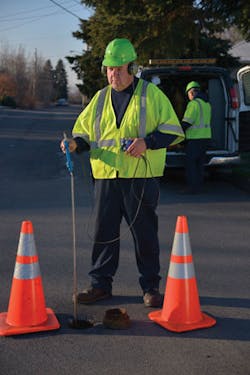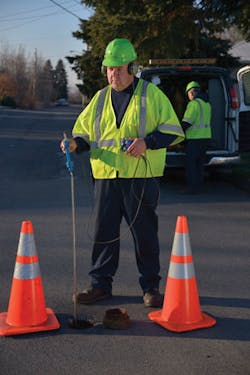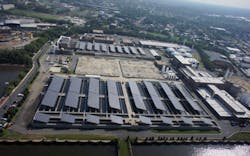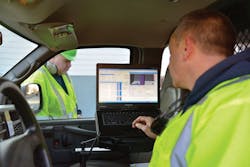Identifying and Addressing the Water-Energy Nexus
By Sarah Fister Gale
Producing energy requires water, and treating water requires energy. This is the crux of the ‘water-energy nexus’ - the latest buzzword designed to draw attention to the explicit relationship between these two vital resources. “Basically, every ounce of water saved is energy saved, and vice versa,” said Dave Ribeiro, senior analyst in the Utilities, State, and Local Policy Program at the American Council for an Energy Efficient Economy (ACEEE). “The overlap is your nexus.”
Government agencies, water and energy utilities, private groups, and industry associations have been focusing on this nexus as they attempt to rein in spending, and adapt to the ongoing drought plaguing the western third of the country. In many states, limited water availability has already constrained the operation of some power plants and other energy production activities, according to Energy.gov, and there is little end in sight.
Hey, Big Spender
Water utilities are often among the biggest users of energy in a community, and energy use is their biggest monthly expense, even ahead of wages. According to EPA, energy costs can represent 25-30 percent of total operation spend for water and wastewater utilities, making it a primary target for efficiency projects to help lower costs and improve the performance of their services. And there is a lot of room for improvement, said Aldie Warnock, senior vice president of public policy for American Water, a national U.S. water and wastewater utility company. “Current water infrastructure loses one out of every four-to-five gallons of water treated,” he said. That is not only a waste of good clean water, it also wastes a huge amount of electricity used to clean and pump water that ends up leaking out of the system.
The good news is that there are many things water utilities can do to improve energy efficiency, and energy utilities are willing to help. Power companies often offer free energy audits, along with programs, rebates and incentives, to help large customers reduce their energy usage. By working with energy utilities, both organizations can achieve benefits, Warnock said. American Water has partnered with energy utilities on several occasions, including an initiative in which PG&E allowed the water utility to use its smart grid in Monterrey, Calif., to provide customers with real-time water usage data and price signals to curb their water use. Because American Water didn’t have its own smart grid technology, they couldn’t have implemented the project as easily on their own, Warnock said. “There are a lot of ‘convergence’ opportunities like this one out there.”
Unfortunately, there are not enough conversations going on between power companies and smaller water utilities, said Matt McCaffrey, director of state regulatory affairs for the National Association of Water Companies.
ACEEE recently reached out to water utilities for research into the energy saving programs they are implementing. Disappointingly, less than half of the utilities they contacted provided any data. Of those that did, more than 80 percent had implemented some form of leak detection projects, yet less than half were doing water conservation, and less than a third had partnered with energy utilities in some way. “Our research showed that there is only a scattering of programs that coordinate to save both energy and water, and there are even fewer programs that are jointly run by electric and water utilities,” Ribeiro said. The research suggests that water utilities could be doing a lot more to track and manage their energy use, and to work with energy utilities to jointly address the water-energy nexus.
“Water utility operators can’t wait around for those conversations to just happen,” McCaffrey added. He argued that it is not the job of either organization to broker those relationships, so someone has to be willing to break the ice. “Call your energy company, ask to speak to someone about energy efficiency projects, and get started,” he said. It’s an easy step to take that can deliver significant long-term savings down the line.
Tiny Bubbles
One example to consider is DC Water. The Washington, D.C., water and sewer authority has a full-time energy expert on staff who works closely with the local energy company, PEPCO, to measure energy use and implement projects to achieve energy efficiencies. “Having someone on staff who understands the energy industry is the first step to making changes,” said George Hawkins, CEO and general manager of DC Water.
When DC Water hired its energy chief several years ago, the first thing he did was conduct an energy audit of all the facilities. He then assembled a list of projects to reduce overall energy use. These ranged from replacing light fixtures and installing variable control pumps to reduce energy waste to more innovative long-ranging plans. One of the first major projects he spearheaded was a $90 million upgrade to the aerobic treatment facility at the Blue Plains Advanced Wastewater Treatment Plant, which included installation of fine bubble diffusers in each of the massive treatment chambers. The new diffusers produce billions of tiny bubbles that rise from the floor of the aeration chamber to transfer oxygen into the water to break down waste. “We discovered that it takes much less energy - and less cost - to push little bubbles than big bubbles,” Hawkins said.
DC Water also built an anaerobic digester system at Blue Plains to generate renewable electricity for the plant, and is currently considering covering the plant in solar panels to generate additional power for the plant and to sell back to the grid. PEPCO has been involved throughout this process, Hawkins said, noting that the energy services division designed and built the current power plant and is operating it on a 15-year renewable contract.
Start Small
While DC Water may be a leader in tracking and managing its water-energy nexus, it is also one of the biggest water utilities in the country - with enough resources and expertise on staff to reasonably implement massive multi-million-dollar projects. But it is the exception. More than 80 percent of water and wastewater utilities across the country have fewer than 3,300 customers, Warnock said. These organizations don’t have the expertise or resources on staff to implement energy tracking and savings programs, and their operators are generally so focused on day-to-day operations that it can be difficult for them to think about analyzing energy usage or implementing energy savings programs - despite the benefits it could bring to their budgets.
But it is possible to have a big impact on energy use with limited resources. East Bay Municipal Utility District is a good example. The San Francisco wastewater utility serves 650,000 customers and was the first wastewater treatment plant in North America to produce more renewable energy onsite than it needed to run its facility, thanks to the construction of an anaerobic digester and installation of an energy-efficient gas. These innovations save EBMUD approximately $3 million per year in power use alone.
And in New Jersey, the Camden County Municipal Utility Authority covered its sewage treatment facility in 7,200 250-watt photovoltaic panels that now produce 2.2 million kilowatt-hours of electricity per year, which has helped the facility significantly lower its electricity usage.
For those utilities that aren’t quite ready to take their operations off the grid, there are easier and less expensive places to start. An energy audit is the best first step in identifying energy efficiency opportunities and to identify low hanging fruit projects, like updating lighting systems or implementing more efficient energy management processes. These smaller initiatives require little time or money and can deliver quick wins that help build support for bigger, more capital-intensive energy efficiency projects down the line.
One Way to Manage the Water-Energy Nexus
At a time when the electric grid and water systems are both getting smarter, the opportunity now exists to significantly optimize the water-energy nexus for those systems.
This requires collecting accurate data about what is happening at meters and along both electric and water distribution systems, and then maintaining and using this data to analyze the best way to reduce cost and energy usage.
“The most effective way to control the water-energy nexus is to gather the data necessary for good analytics through a single, unified network that allows collection of water, electric, and gas data into a single head-end system, where it can be analyzed to identify where the utility is wasting resources,” said Todd Stocker, director of water and gas markets for Aclara.
Aclara specializes in smart infrastructure for utilities. The company recently introduced the Synergize™ RF network, a single system for reading water, gas and electric meters as well as other devices on distribution networks.
About the Author: Sarah Fister Gale is a freelance journalist based in Chicago, Ill. Over the last 15 years, she has researched and written dozens of articles on water management trends, wastewater treatment systems and the impact of water scarcity on businesses and municipalities around the world.
More WaterWorld Current Issue Articles
More WaterWorld Archives Issue Articles






